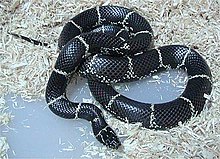zh-TW
在導航的名稱

Kingsnakes are colubrid New World members of the genus Lampropeltis, which includes 26 species. Among these, about 45 subspecies are recognized. They are nonvenomous and ophiophagous in diet.
Kingsnakes vary widely in size and coloration. They can be as small as 24" (61cm) or as long as 60" (152cm).[2] Some kingsnakes are colored in muted browns to black, while others are brightly marked in white, reds, yellows, grays, and lavenders that form rings, longitudinal stripes, speckles, and saddle-shaped bands.[3]
Most kingsnakes have quite vibrant patterns. Some species, such as the scarlet kingsnake, Mexican milk snake, and red milk snake, have coloration and patterning that can cause them to be confused with the highly venomous coral snakes. One of the mnemonic rhymes to help people distinguish between coral snakes and their nonvenomous lookalikes in the United States is "red on black, a friend of Jack; red on yellow, kill a fellow". Other variations include "red on yellow kill a fellow, red on black venom lack",[4][5] and referencing the order of traffic lights "yellow, red, stop!" All these mnemonics apply only to the three species of coral snakes native to the southern United States: Micrurus fulvius (the eastern or common coral snake), Micrurus tener (the Texas coral snake), and Micruroides euryxanthus (the Arizona coral snake). Coral snakes found in other parts of the world can have distinctly different patterns, such as having red bands touching black bands, having only pink and blue bands, or having no bands at all.
Lampropeltis includes the Greek words for "shiny shield":[6] λαμπρός lampro(s) ("shiny") + πέλτη pelt(ē) ("peltē shield") + -is (a Latin suffix). The name is given to them in reference to their smooth, enamel-like dorsal scales.[7]
The "king" in the common name (as with the king cobra) refers to its preying on other snakes.[8]
Taxonomic reclassification of kingsnakes, as with many herpetiles and other animals, is a neverending process. Unexpected hybridization between kingsnake species and/or subspecies with adjacent home territories is not uncommon, thus creating new color morphs and variations, and further providing classification challenges for taxonomists; Often, different researchers will “agree to disagree”, one potentially citing a source that proves independent species-status to a group of wild snakes, while another will set out to prove that a discovered group is but a regional subspecies.
In the case of L. catalinensis, for example, only a single specimen is known, thus classification is not necessarily finite; this individual could be the lone uniquely-colored snake out of a more uniformly-colored litter, or even be the one documented example of a presently-unknown, localized subspecies. The entire system actively unfolding indefinitely.
Kingsnakes are native to North America, where they are found all over the United States and into Mexico. This genus has adapted to a wide variety of habitats, including tropical forests, shrublands, and deserts.[9] As a whole, kingsnakes are found coast-to-coast across North America, with some as far north as Montana, North Dakota, New Jersey, Illinois and Ohio; south of those areas, there are kingsnakes to be found in nearly every corner of the lower-48 United States. Kingsnakes are also found virtually coast-to-coast across México, all the way down to the México-Guatemala border. Further south from there, milksnakes become the more predominant kingsnake in Central America, such as the Honduran milk snake.
Kingsnakes are often preyed upon by large vertebrates, such as birds of prey. Tarantulas also sometimes prey on them; however, a considerable threat also comes from other kingsnakes. All species of kingsnakes are known snake- and reptile-eaters, and likely won't turn down a chance to prey on their local competitors.[10]
Kingsnakes are primarily terrestrial, but they are also known to be capable climbers and swimmers.[9]
Kingsnakes use constriction to kill their prey and tend to be opportunistic in their diet. They are known to seek out and eat other snakes (ophiophagy), including venomous snakes, like rattlesnakes, cottonmouths, hognoses and copperheads. Some known non-venomous prey species of the kingsnake include gopher snakes, corn snakes, bullsnakes, garter snakes, rosy boa, water snakes, and brown snakes. Kingsnakes also eat many species of lizards, rodents, birds, and eggs.[11] The common kingsnake is known to be immune to the venom of other snakes and does eat rattlesnakes, but it is not necessarily immune to the venom of snakes from different localities.[11]
Kingsnakes such as the California kingsnake can exert twice as much constriction force relative to body size as rat snakes and pythons. Scientists believe that such strong coils may be an adaptation to eating snakes, and other reptile prey, which can endure lower blood-oxygen levels before asphyxiating.[12]




Kingsnake species and subspecies include (listed here alphabetically by specific and subspecific name):[13]
Additionally, Pyron and Burbrink have argued that the short-tailed snake (Stilosoma extenuatum) (Brown, 1890) should be included in Lampropeltis.[14]
{{cite web}}: CS1 maint: url-status (link) Kingsnakes are colubrid New World members of the genus Lampropeltis, which includes 26 species. Among these, about 45 subspecies are recognized. They are nonvenomous and ophiophagous in diet.